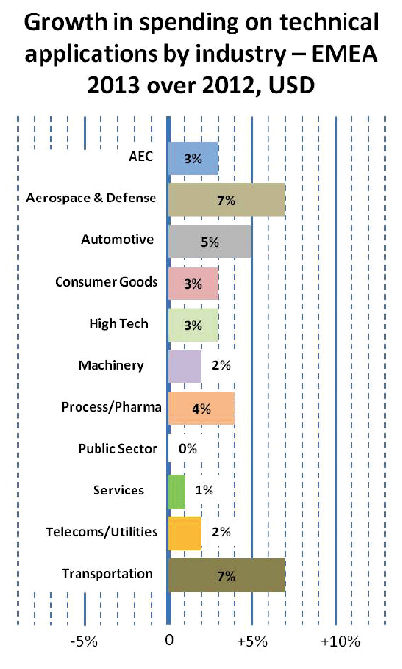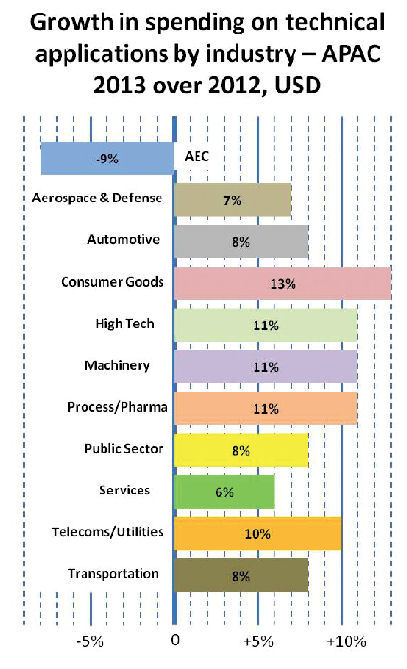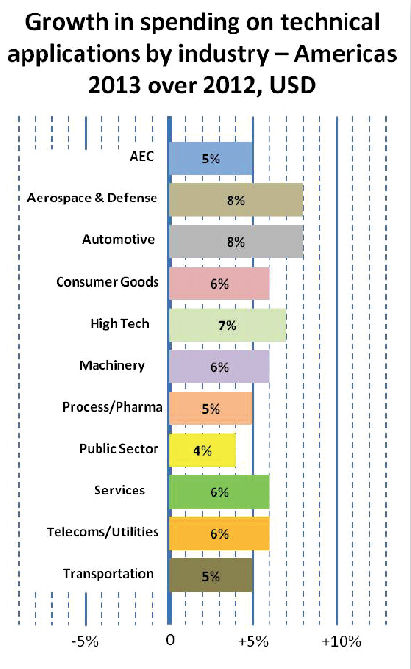Latest News
May 1, 2013
By Tony Cambashi
As we progress through the second quarter of the new year, the market for CAD/CAE, product lifecycle management (PLM) and related applications—collectively, the “technical applications market”—seems to be relatively healthy. A major factor why is the widespread recognition that the technology industries are the ones that can generate sustainable growth.
In the Americas, Europe, the Middle East and Africa (EMEA), and the Asian-Pacific (APAC)—the overall markets show likely growth. From the technology side, with due acknowledgement to Porter’s five forces framework for analyzing the attractiveness of target industries in the context of business strategy, we can apply the more tangible notion of “five technology forces” to the drivers that will shape the technical applications market this year.
During 2012, these “forces” became established as the main technology drivers for both the development activities of the application providers and the adoption strategies of user organizations. They are now embedded as the factors that, in 2013, will combine to deliver unprecedented access to design applications and new possibilities for designers to collaborate on new product development projects. As a result, 2013 looks set to be an exciting time for the industry.
Let’s examine each force for its potential to change today’s technical applications landscape.
1. The Cloud
First of all, the promise of the cloud is to remove a limited ability to invest in IT infrastructure as a barrier to access to applications. This promise can be extended to saying that the “simple applications for the small guys and the sophisticated applications for the large guys” paradigm can be broken.
Even if we disregard the tidal wave of hype that still surrounds the cloud, there is a lot of validity in the promise. In 2012, several major technical applications vendors stepped up their efforts to make their applications available in cloud-based environments—and we expect that, by the end of 2013, a substantial number of user organizations will be accessing the applications in this way.
Leading technical applications vendors are offering cloud-based deployments. For example:
· The Autodesk 360 environment already incorporates Fusion 360—a wide-ranging set of design technology that supports seamless design workflows. There’s also PLM 360, the company’s PLM system.
· Dassault Systemes has promoted its commitment to cloud-based delivery of applications.
· PTC’s Windchill PLM system can be hosted and managed using IBM Services.
· Siemens PLM announced in October the cloud-based deployment of Siemens’ Teamcenter, with specific certifications for Microsoft’s Windows Azure, IBM’s SmartCloud Enterprise+, and Amazon Web Services.
2. Mobility
Mobility practically goes hand-in-hand with the cloud. So, in parallel with making applications cloud-based, several major vendors have made substantial progress in embracing mobile devices—either as access to the enterprise applications or in the form of reduced-scale (low-end) versions of applications that will run on mobile devices.
 |
Here again, Autodesk has firmly set out its commitment to both aspects of making mobile applications readily available. In terms of reduced-scale applications designed to run on mobile devices, the company has reported approximately 100 million downloads of low-cost, mobile device-based software to-date.
3. Social Networking
The increasing use of social networking technologies in all walks of life is being exploited to great effect to facilitate collaboration, whether in new product development projects or after-sale maintenance of products.
Of course, the tie-in to mobile devices is a vital aspect of this—for example, the ability for field personnel to access product information held in the PLM environment has been a major focus for Siemens PLM recently, and huge progress has been made in this area. A great example of the use of social networking in the design phase is the crowdsourcing approach to “recruiting” design input for projects.
 |
4. Integration
Advances in integration have come in a number of guises. Firstly, there has been substantial progress in integrating the individual applications that serve the different phases of the design and development workflow, from concept design all the way to manufacture.
The result is much better feedback from one phase to another, such as the impact back on the initial concept of simplifications suggested downstream to overcome manufacturing complexities. This reduces errors, timescales and costs.
In the PLM domain, the integration focus has been on bringing more of the product information within the scope of the PLM data management environment. The standout aspect of this is embedded software. Previously, software development was managed as a product in its own right and with its own lifecycle. As more physical products exploit embedded software, however, many PLM vendors are working to bring embedded software into the PLM environment. A good example of this is PTC’s acquisition of software lifecycle management technology vendor MKS.
5. Ease of Use
Improved integration has led to many applications becoming much easier to use, thanks to mechanisms like common menu structures and higher automation of background tasks. This improves designers’ ability to undertake a broader range of the tasks involved.
One notable example is the initial—and for simple products, perhaps entire—simulation and analysis activity. One example is Mentor Graphics’ integration of its 1D (system-level) analysis technology and its 3D (component-level) technology.
 |
When Forces Collide
The combination of the five forces is leading to rapid democratization of what were previously specialist tools. As we head toward the second half of 2013, the question of what needs to remain specialist and what can be done by the design all-rounder is a very hot topic.
A good example of this is simulation and analysis technology. There is no doubt that with the latest tools, engineering designers can take their simulations and analysis work to a new level; where that level is set before the need to involve a specialist arises is still an open question (and, of course, varies by industry), one that will attract a lot of attention in the coming months. Nevertheless, the death of the specialist, to borrow from the famous quotation, is greatly exaggerated. DE
Tony Christian is director of the research analyst and consulting company Cambashi. Send e-mail about this article to [email protected].
Subscribe to our FREE magazine, FREE email newsletters or both!
Latest News






